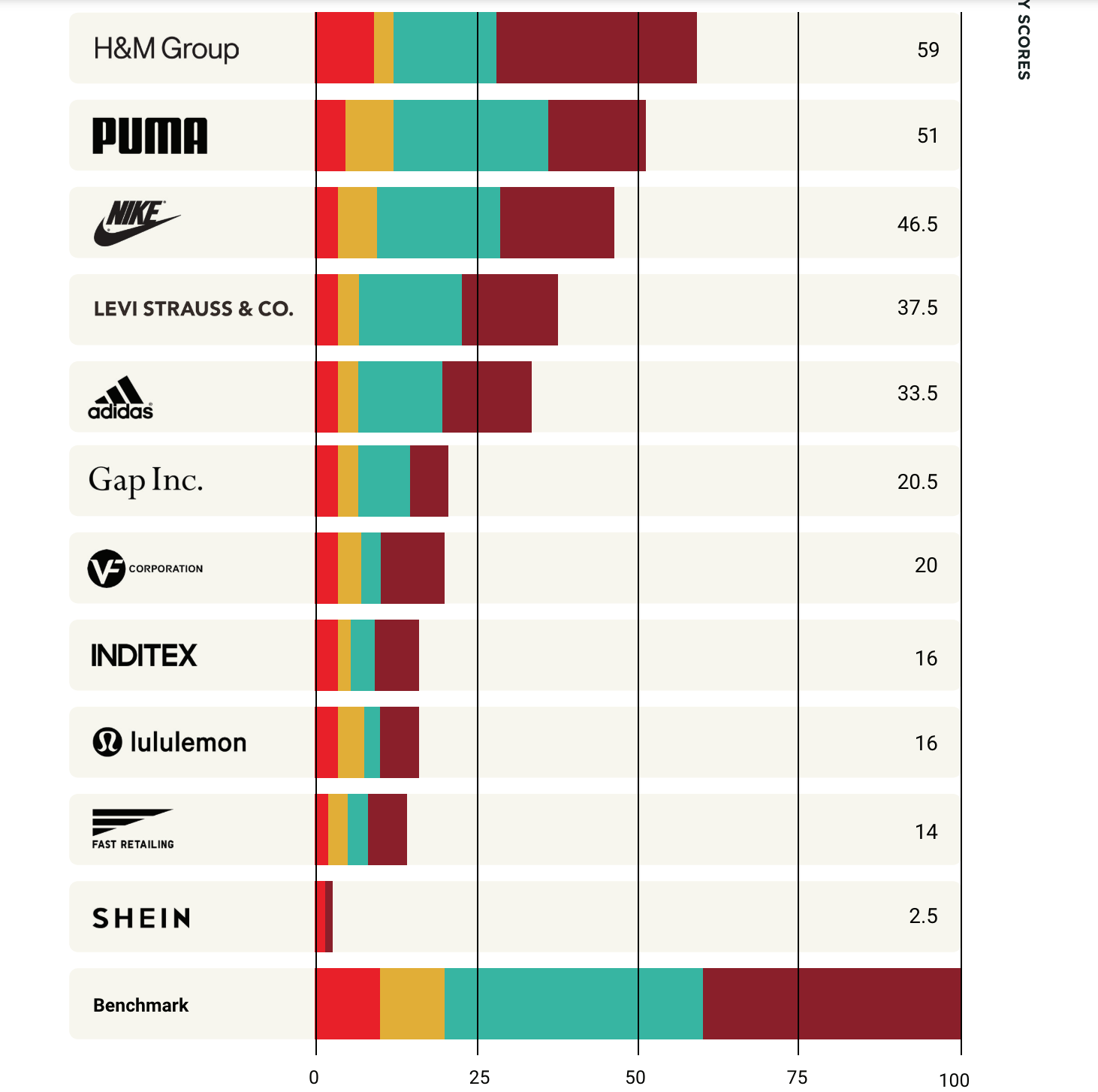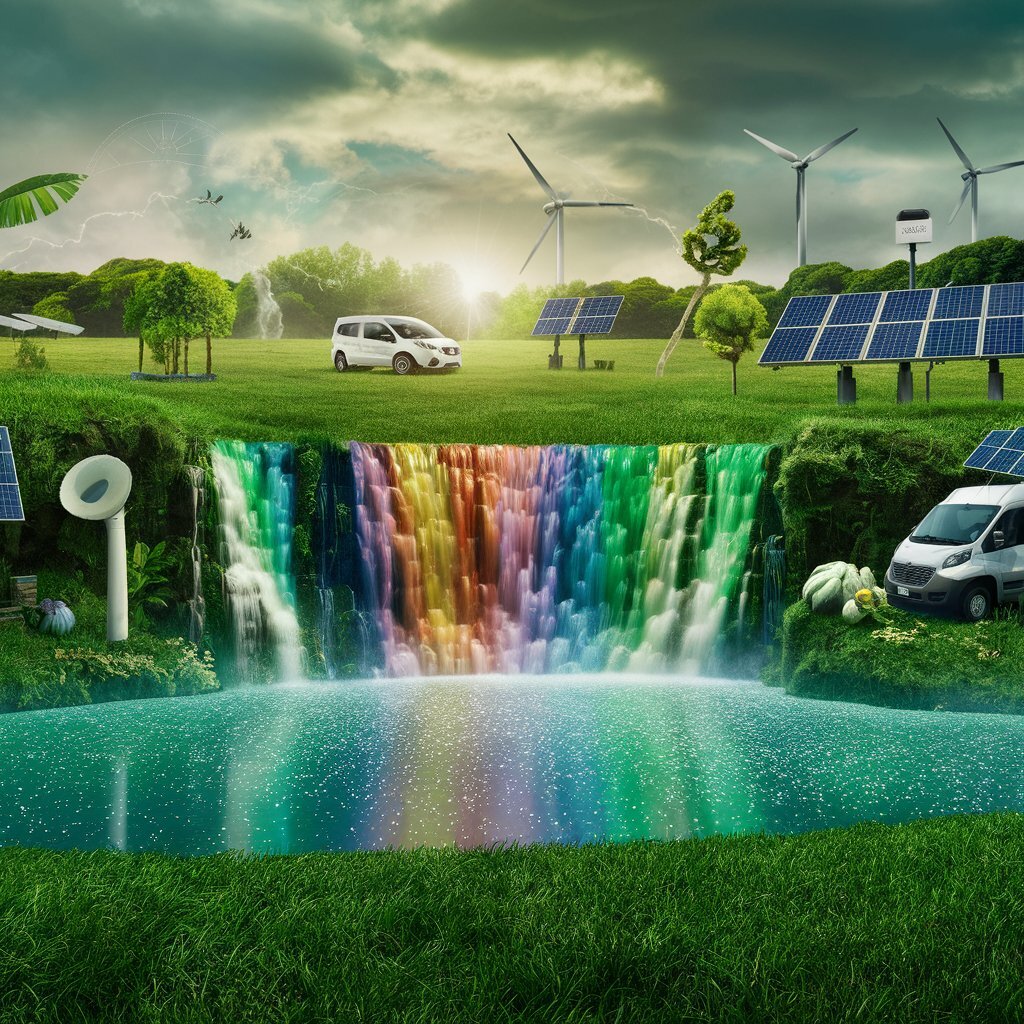Stand.earth released its 2024 update to last year’s Fossil-Free Fashion Scorecard, revealing that the world’s leading fashion companies continue to rely heavily on fossil fuels, showing insufficient progress in decarbonizing their supply chains. "The 2024 Clean Energy Close Up" provides a detailed analysis of the tangible progress—or lack thereof—among 11 of the most influential global fashion brands in reducing emissions, phasing out coal, and transitioning to renewable energy. This report measures their performance against the pathway to an equitable fossil fuel phase-out by 2030, based on publicly available data from their supply chains.
Key Findings
The report's findings are concerning, indicating that most of the 11 leading fashion brands analyzed scored less than 25 out of 100 possible points. This demonstrates a significant lack of progress towards decarbonization. Only Levi’s, Puma, and H&M are on track to reduce manufacturing emissions by at least 55% by 2030 compared to 2018 levels—a target that is only six years away.
Brand Performance Scores:
Below are brand scores, with H&M, Puma, and Nike earning the highest scores, while Lululemon, Fast Retailing (e.g., Uniqlo), and Shein scored last:
Key Findings
The report's findings are concerning, indicating that most of the 11 leading fashion brands analyzed scored less than 25 out of 100 possible points. This demonstrates a significant lack of progress towards decarbonization. Only Levi’s, Puma, and H&M are on track to reduce manufacturing emissions by at least 55% by 2030 compared to 2018 levels—a target that is only six years away.
Brand Performance Scores:
Below are brand scores, with H&M, Puma, and Nike earning the highest scores, while Lululemon, Fast Retailing (e.g., Uniqlo), and Shein scored last:

Troubling Emissions Trends
One of the most alarming findings is from fast-fashion giant Shein, which scored just 2.5 out of 100. Shein's absolute emissions surged by nearly 50% in a single year, now exceeding the annual emissions of Paraguay. This rapid growth in emissions from Shein alone threatens to negate the progress made by more traditional brands.
Greenwashing and Regulatory Scrutiny
Complicating the transition to clean energy is the issue of greenwashing, where some brands use marketing tactics to obscure their true environmental impact. Recently, the Canadian Competition Bureau launched an inquiry into Lululemon, following a complaint by Stand.earth alleging misleading environmental claims by the company.
Statements from Stand.earth
“The good news is that progress is happening. The bad news is that it is being undermined by dangerous pollution from ultra-fast fashion and the growing threat of greenwashing. Simply put, most brands are not yet on track to decarbonize, and many are heading in the wrong direction,” said Rachel Kitchin, Senior Corporate Climate Campaigner at Stand.earth and the report’s lead author. “These big players in the fashion industry must show leadership by rapidly phasing out fossil fuels and investing in tangible, renewable energy solutions.”
One of the most alarming findings is from fast-fashion giant Shein, which scored just 2.5 out of 100. Shein's absolute emissions surged by nearly 50% in a single year, now exceeding the annual emissions of Paraguay. This rapid growth in emissions from Shein alone threatens to negate the progress made by more traditional brands.
Greenwashing and Regulatory Scrutiny
Complicating the transition to clean energy is the issue of greenwashing, where some brands use marketing tactics to obscure their true environmental impact. Recently, the Canadian Competition Bureau launched an inquiry into Lululemon, following a complaint by Stand.earth alleging misleading environmental claims by the company.
Statements from Stand.earth
“The good news is that progress is happening. The bad news is that it is being undermined by dangerous pollution from ultra-fast fashion and the growing threat of greenwashing. Simply put, most brands are not yet on track to decarbonize, and many are heading in the wrong direction,” said Rachel Kitchin, Senior Corporate Climate Campaigner at Stand.earth and the report’s lead author. “These big players in the fashion industry must show leadership by rapidly phasing out fossil fuels and investing in tangible, renewable energy solutions.”

Signs of Progress
While overall progress is limited, there are encouraging signs. For instance, Puma reported a significant increase in clean energy use, with 27.4% of its electricity coming from renewables across its key supplier tiers. However, for this growth to be credible, Puma must provide detailed reports on on-site power generation and power purchase agreements rather than relying on renewable energy credits (RECs).
H&M stands out for offering grants to suppliers to install rooftop solar, making it the only brand to do so. However, the company still needs to fully disclose its progress in phasing out fossil fuels and shifting to renewable energy.
Interactive Tools and Recommendations
The report is accompanied by a newly released Fashion Supply Chain Map, an interactive tool that explores the intricate supplier relationships within the fashion industry. This map highlights the stark gap between brands' ambitious targets and their actual implementation.
“Right now, manufacturers are acting as ‘the fall guy’ for fashion’s climate pollution, while brands reap the profits from a safe distance,” Kitchin added. “Brands’ failure to take responsibility for their emissions by funding and enabling the transition to renewables, while continuing to increase production, will perpetuate fossil fuel dependence in the Global South, causing harmful health and climate impacts for decades. Brands need to finance the renewable energy transition in their supply chains and be more transparent about their suppliers and locations.”
While overall progress is limited, there are encouraging signs. For instance, Puma reported a significant increase in clean energy use, with 27.4% of its electricity coming from renewables across its key supplier tiers. However, for this growth to be credible, Puma must provide detailed reports on on-site power generation and power purchase agreements rather than relying on renewable energy credits (RECs).
H&M stands out for offering grants to suppliers to install rooftop solar, making it the only brand to do so. However, the company still needs to fully disclose its progress in phasing out fossil fuels and shifting to renewable energy.
Interactive Tools and Recommendations
The report is accompanied by a newly released Fashion Supply Chain Map, an interactive tool that explores the intricate supplier relationships within the fashion industry. This map highlights the stark gap between brands' ambitious targets and their actual implementation.
“Right now, manufacturers are acting as ‘the fall guy’ for fashion’s climate pollution, while brands reap the profits from a safe distance,” Kitchin added. “Brands’ failure to take responsibility for their emissions by funding and enabling the transition to renewables, while continuing to increase production, will perpetuate fossil fuel dependence in the Global South, causing harmful health and climate impacts for decades. Brands need to finance the renewable energy transition in their supply chains and be more transparent about their suppliers and locations.”


Conclusion and Call to Action
The 2024 Clean Energy Close Up builds on Stand.earth’s Fossil Free Fashion Scorecard, which has evaluated fashion brands' sustainability initiatives for years. This latest analysis provides detailed recommendations to help these industry giants correct their course and achieve the goal of reducing emissions by 55% by 2030. The report underscores the urgent need for a dramatic transformation of the fashion supply chain away from fossil fuels.
The fashion industry, a multi-trillion-dollar sector, is responsible for 2 to 8% of global greenhouse gas emissions, with these emissions projected to increase significantly by 2030. The industry’s reliance on coal and other fossil fuels not only undermines climate stability but also severely impacts the health of supply chain workers and their communities. A 2021 Harvard University study found that one in five deaths globally can be linked to air pollution caused by burning fossil fuels.
The Clean Energy Close Up report makes it clear: meaningful progress is essential, and the fashion industry must act now to transition to a sustainable, fossil-free future.
The 2024 Clean Energy Close Up builds on Stand.earth’s Fossil Free Fashion Scorecard, which has evaluated fashion brands' sustainability initiatives for years. This latest analysis provides detailed recommendations to help these industry giants correct their course and achieve the goal of reducing emissions by 55% by 2030. The report underscores the urgent need for a dramatic transformation of the fashion supply chain away from fossil fuels.
The fashion industry, a multi-trillion-dollar sector, is responsible for 2 to 8% of global greenhouse gas emissions, with these emissions projected to increase significantly by 2030. The industry’s reliance on coal and other fossil fuels not only undermines climate stability but also severely impacts the health of supply chain workers and their communities. A 2021 Harvard University study found that one in five deaths globally can be linked to air pollution caused by burning fossil fuels.
The Clean Energy Close Up report makes it clear: meaningful progress is essential, and the fashion industry must act now to transition to a sustainable, fossil-free future.

